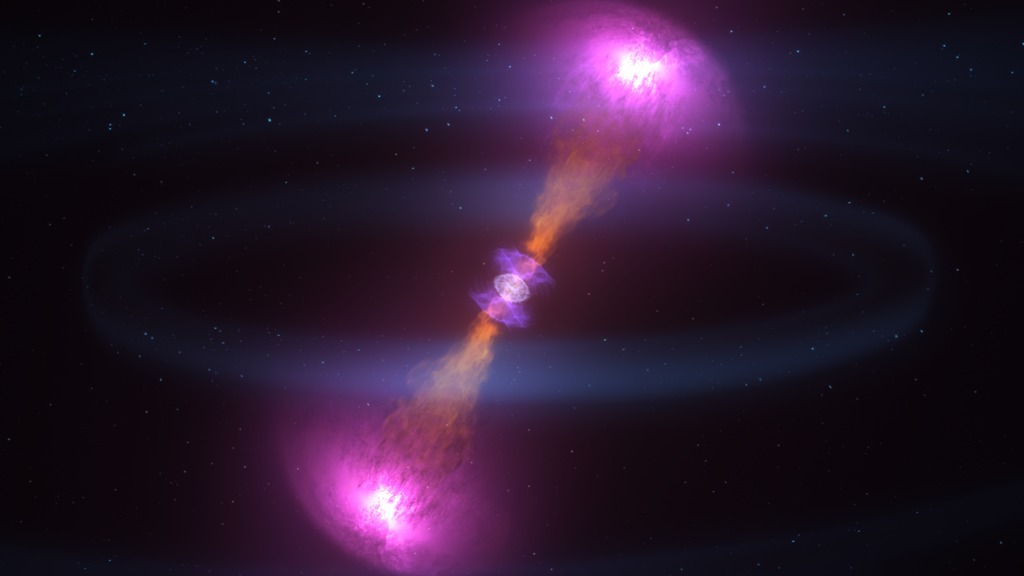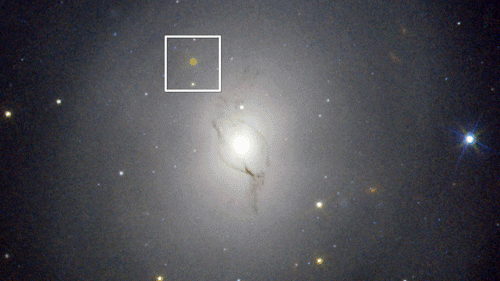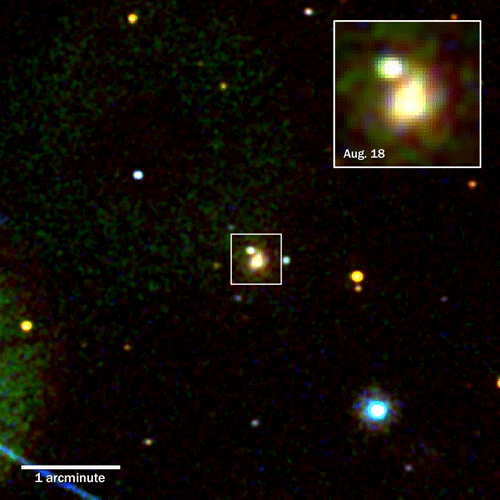2 Neutron Stars Collided, So Are They a Black Hole Now?
For the first time, scientists have seen the source of gravitational waves from two colliding neutron stars, and the space oddity doesn't stop there. Those neutron stars might have collapsed into a black hole after they merged, scientists say.
On Aug. 17, 2017, the gravitational-wave observatories LIGO (short for the "Laser Interferometer Gravitational-wave Observatory") and Virgo detected a strong signal from the galaxy NGC 4993. Scientists pinpointed the source of that signal in the sky, and an international collaboration immediately sprung forth to observe the event with terrestrial and space observatories. Researchers detected light from the neutron-star crash across the entire electromagnetic spectrum, beginning with a burst of high-energy gamma-rays seconds after the gravitational waves were detected.
The observations indicate that the waves and light came from a pair of merging neutron stars about 130 million light-years away, according to a news conference on Monday Oct. 16, 2017. Neutron stars are the incredibly dense remnants of stars that have exploded in supernovas. The two that merged were 1.6 and 1.1 times as massive as our sun, but each was no wider than Washington, D.C., according to a statement by the Space Telescope Science Institute. [When Neutron Stars Collide! What Telescopes Saw (Videos)]

As the stars spiraled into each other, they sent gravitational waves through the universe and released tremendous amounts of light when they finally collided. Scientist call the phenomenon a "kilonova."
"We don't actually know what happened to the objects at the end," David Shoemaker, a senior research scientist at MIT and a spokesman for the LIGO Scientific Collaboration, said at a news conference today (Oct. 16) at the National Press Club in Washington, D.C. "We don't know whether it's a black hole, a neutron star or something else."
From neutron stars to black hole?
Such a massive object could collapse under its own weight, forming a black hole. A black hole is essentially a point of infinite density surrounded by a region of no return — the event horizon, inside which not even light can escape.
Get the Space.com Newsletter
Breaking space news, the latest updates on rocket launches, skywatching events and more!
If the new object did collapse into a black hole, "it's the lightest one that we know about," Harvard astronomer Edo Berger said at the news conference. Berger's team analyzed the light from the kilonova and found evidence of superheavy elements, like gold and platinum, forged in the violent event. [What Neutron Stars Are Made Of (Infographic)]

Eleonora Troja, a high-energy astrophysicist at the University of Maryland and NASA's Goddard Space Flight Center, expressed a bit more confidence in what the new object may be. "[It's] very likely the collision of two neutron stars resulted in a new black hole," she said at the news conference.
Troja has good reason to believe the stars did form a black hole. Right after the gamma-rays and gravitational waves were detected on Earth, NASA's Swift Gamma-Ray Burst observatory, which orbits high above Earth, returned some interesting results: a bright source of ultraviolet light, but no X-rays. This was the first time in the Swift observatory's 13 years of working on the mission that it had come up empty-handed, according to Troja. NASA's Chandra X-ray Observatory, and Nuclear Spectroscopic Telescope Array (NuSTAR), also saw nothing in the X-ray spectrum.
A signal! But from what?
Nine days after the gravitational waves were detected by LIGO and Virgo, Troja's team finally picked up a faint X-ray signal — one so weak only the space-based Chandra X-ray Observatory could detect it.
For Troja, the faint signal suggests the presence something far more powerful: jets of matter and radiation spewing the same amount of energy in a few days that the sun radiates over millions of years.
The paltry signal was an effect of the viewing angle, Raffaella Margutti, an astrophysicist at Northwestern University, told Space.com. It took nine days for the jet to spread out enough for the spray of X-rays to begin hitting Earth, she said. Margutti is the lead author on one of the Chandra X-ray Observatory studies that resulted from the discovery, and a coauthor on at leat eight related studies.

Margutti cautioned that many astronomical objects can produce jets. They simply need enough energy to feed a stream of material and an axis of rotation to establish the direction from which the material shoots out.
"There's nothing obvious … that would tell us that the remnant was a black hole or neutron star," Margutti said.
X-ray and radio observatories are still gathering data on the kilonova remnant, but scientists may never know what became of the two stars. "Once the light is off, we will never see it again," Margutti said.
Email Harrison Tasoff at htasoff@space.com or follow him @harrisontasoff. Follow us @Spacedotcom, Facebook and Google+. Original article on Space.com.
Join our Space Forums to keep talking space on the latest missions, night sky and more! And if you have a news tip, correction or comment, let us know at: community@space.com.

Harrison Tasoff is a science journalist originally from Los Angeles. He graduated from NYU’s Science, Health, and Environmental Reporting Program after earning his B.A. in mathematics at Swarthmore College. Harrison covers an array of subjects, but often finds himself drawn to physics, ecology, and earth science stories. In his spare time, he enjoys tidepooling, mineral collecting, and tending native plants.









